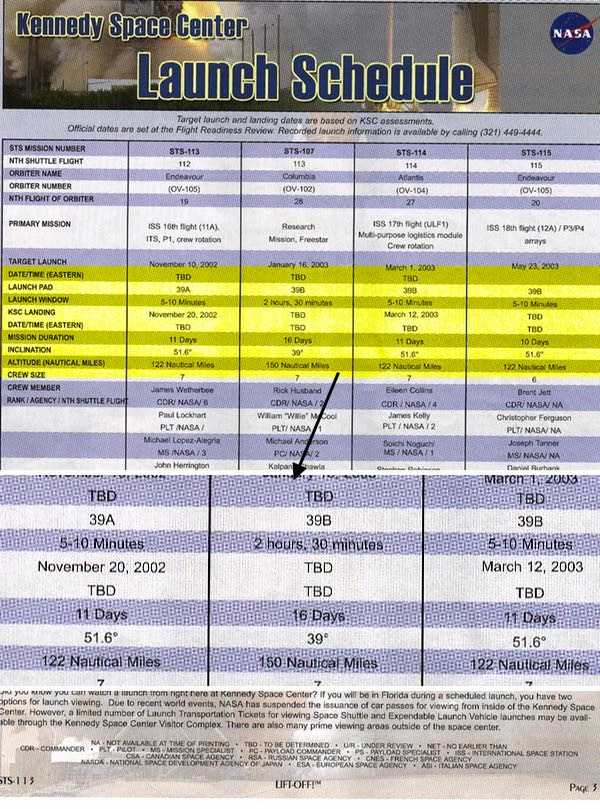- Hi Guys,
- This fellow Steve Parrish has it all wrong. What he calls
the "angle of descent"
- for the Shuttles is actually the orbital inclination.
ALL of them descend at the same angle on re-entry. The reason all the others
have an inclination of 51.6 degrees is because that's the orbital inclination
of ISS, and the Shuttles must use that inclination in order to rendezvous
with ISS. ISS is orbiting at 240nm +- 10, so Shuttle missions to ISS must
also orbit at this altitude. Columbia's last mission was at 150nm with
an orbital inclination of 39 degrees because it was a science flight, and
in no way involved with ISS.
- BTW, the orbital inclination is the angle of the orbit
relative to the equator, and has nothing to do with the angle of descent
on re-entry.
- Take care, and may God Bless you and yours.
- Kindest Regards,
As Always,
Jeff Challender
-
-
- Comment
-
- From Milt
- Zodiacwks@aol.com
- 2-3-2
-
- Dear Jeff --
-
- "Steve Parrish's" concerns are legitimate,
but his interpretation of the
- data is off. The "inclination" listed refers
to the orbital angle with
- respect to the equator, NOT the angle of attack during
reentry. Nonetheless,
- there IS a terribly serious problem associated with this
difference!
-
- The "different" mission parameters shown
on the schedule reflect the
- differences between STS missions that are going to the
International Space
- Station (high inclination) and non-ISS flights (lower
inclination).
-
- Actually, it was Richard Hoagland who addressed
exactly this issue on
- Coast to Coast last night [during the third hour of a
special broadcast]. Because of the need to accommodate the more northerly
Russian launch facility
- (located at a much higher latitude than the Cape here
in Florida), the ISS'
- orbit is much more tilted with respect to the equator
than would otherwise be
- required. [James Oberg has described the political and
technical reasons
- behind this situation in detail in his recent book, Star
Crossed Orbits, and
- on Jeff's program.]
- In addition, Richard pointed out that -- because
of the lack of
- sufficient onboard fuel supplies on Columbia -- the Shuttle
could not change
- orbits (i.e., go from a 39 degree inclined orbit to a
51.6 degree inclined
- orbit) to reach the ISS as a safe refuge in space.
-
- If, as Richard pointed out, the Shuttle had sustained
some damage to its
- tiles, going to the ISS would have been by far the wisest
and most prudent
- thing to do -- IF it could have gotten there! Instead,
lacking the fuel
- needed to change orbits, the crew of the Columbia had
to "suck it in" and
- attempt a reentry whatever the risks.
-
- Of course, for decades NASA "policy" has
been to deliberately keep the
- Shuttle a vehicle that "cant go anywhere" for
lack of additional onboard fuel
- tanks. [Why?] This time, that policy may have killed
seven people.
-
From: "Steve Parrish"
- To: <webmaster@rense.com>
- Subject: STS-107 Research Mission Freestar with Attachment
- Date: Sat, 1 Feb 2003 15:39:37 -0800
- ------------------------------------------------------------------------
-
-
- STS-107 RESEARCH MISSION FREESTAR
-
-
- Rense,
-
- Please check this out. This schedule was handed out during
the Endeavor lift off last November. The COLUMBIA schedule is also here.
If you look at the descent inclination, Columbia is the only one with a
39 degrees angle and the others are 51.6-degrees angle. The altitude (nautical
miles, Columbia is the only one at 150 nautical miles.) you will see Columbia
is different from the other shuttle missions.
-
- 150 nautical miles x 6076.115 ft (1 nautical mile) =
911,417.250 ft. 911,417.250 ft. descent to 200,700 ft. at a 39 degree angle
= structure failure, resulting in disintegration. If you have any questions
regarding the authenticity of this program page, please contact me/
-
- Stephen Parrish
-
- North Hollywood, CA
|

